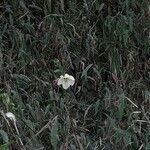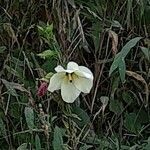Herbs annual or perennial, 1-2 m tall, most parts long simple-hispid and minutely simple-or few-rayed pubescent. Stipules linear-lanceolate, sometimes 2 on each side of petiole, 1-1.5 cm; petiole 6-18 cm; leaf blade palmately 5-9-lobed, 15-30 cm in diam., lobes oblong-lanceolate, sometimes ± pinnately lobed, 8-18 × 1-6 cm, sparsely long hispid on both surfaces, margin robustly, obtusely serrate. Flowers solitary, subapical and forming terminal raceme; pedicel 1.5-4 cm. Epicalyx lobes 4 or 5, ovate-lanceolate, 15-25 × 4-5 mm, sparsely long hispid. Calyx spathaceous, minutely 5-lobed, nearly entire, longer than epicalyx, puberulent only, not hispid, caducous at fruiting. Corolla yellow with purple center, ca. 12 cm in diam. Staminal column 1.5-2.5 cm; anthers nearly sessile. Stigma purple-black, spatulate-disk-shaped. Capsule ovoid-ellipsoid, 4-5 × 2.5-3 cm, densely hirsute. Seeds many, reniform, with several lines of hairs. Fl. Aug-Oct.
More
A branched shrub up to 2 m or more high. It has rounded twigs which are green and smooth. The leaves are simple, smooth and with 3 to 5 lobes. The leaves are large and can vary in shape. Normally the leaves are very dark green, but occasionally pale green types occur. The leaf stalks are 6 to 13 cm long. The stalks can be green or have red colours on them. The flowers are borne singly and are yellow with dark purple centres. They are produced on mature bushes and the flowers are hibiscus like. The fruit pods are rather stiff or with bristly hairs. They are a dry capsule with many small seeds. Plants can last for a year or for several years. Old plants produce a hibiscus type flower.
A tropical plant. It is well suited to the tropical lowlands but grows only poorly at 1800 metres. It needs fertile soil. The plant occurs in countries from India, China, Japan, Malaysia and Indonesia to the Pacific Islands. Plants will withstand occasional short-lived temperatures down to about-5°C so long as they are in a very well-drained soil. It suits areas with high humidity. It does not do well on atoll soils. It grows in humid places in Africa usually between 12°N and 12°S. It does best in well drained sandy loams. It suits hardiness zones 10-12. Hobart Botanical Gardens. In Sichuan and Yunnan.
More
Wasteland and humid rocky hillsides. In Nepal it grows at elevations of 700-1,700 metres in rocky places with shrubs. Grasslands, near streams and margins of farm land.
Wasteland and humid rocky hillsides. In Nepal it grows at elevations of 700-1,700 metres in rocky places with shrubs. Grasslands, near streams and margins of farm land.
Young leaves are cooked and eaten. They are slimy unless steamed or fried. They can be eaten with papaya leaves to remove the bitterness of the papaya. The root is boiled with pork to make a broth. The young fruit are cooked and eaten. They can be dried and also ground to a powder. The fruit make dishes go slimy.
It is grown from cuttings. Cuttings with 2-3 nodes are sufficient. It can be grown from seeds. The narrow leafed types tend to compete less well with weeds. In some areas people tend to put the narrow leafed types in the middle of the garden, intercropped with sweet potato, and the broad leafed kinds near stumps or logs and around the edges of gardens. The pale green leafed kinds that occur only grow very slowly. Aibika is normally grown from cuttings. Lengths of about 25 cm (2 or 3 leaf joints or "nodes") of fresh green stem cuttings are used. These are simply stuck in the ground. A fertile soil is needed. Therefore Aibika can be planted in good soil in a newly cleared garden site, or it can be planted near houses where the soil fertility can be built up by adding scraps and compost and ashes. The growth and colour of Aibika leaves can be improved greatly by spraying the leaves each 2 or 3 weeks with a very small amount of the nitrogen fertiliser called urea, dissolved in water. (A 0.5% solution). This uses less fertiliser than putting it on the ground where it can wash away in the rain. Picking out the tips off branches of Aibika plants encourages the plant to produce more branches and therefore more leaves. But when you are harvesting leaves, you should not pick too many off the one bush at the one time. This is because it slows down the growth of more leaves. If the soil is very fertile, older bushes, which are only growing a few leaves, can be chopped off. The stump left in the ground can then re-grow into a new bush.


